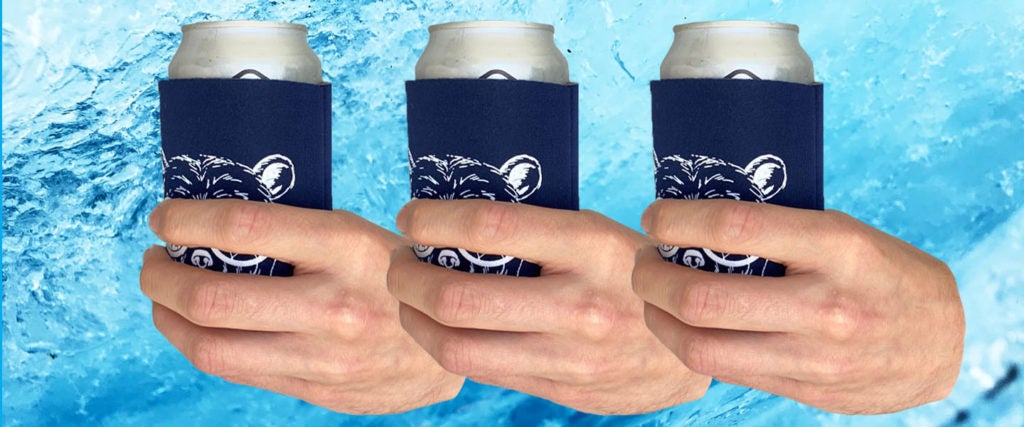The koozie: It’s great for providing a solid grip on your beer, especially if you’re a dog. It’s great for knowing which beer is yours when you set yours down to take a leak — and especially when you need to say to someone, “Hold my beer!” It even keeps your hand dry and mostly unclammy during barbecues, daytime partying or just backyard chills. But mostly they’re great because nothing will harsh the mellow of this kind of gathering more than warm beer.
Everyone knows the real point of a koozie — supposedly — is to keep your beer cold. But has anyone actually looked into this? Has science provided a definitive answer on whether your little Green Bay Packers neoprene-wetsuit-for-a-beer-vessel actually keeps the malted beverage within it from getting warm, and thus progressively less crushable?
Amazingly: Yes!
So does science say anything about this?
We’re in America, damn it — of course science has looked into this! In 2013, Dale Durran, a professor of atmospheric sciences at the University of Washington, published a landmark study (for the koozie industry, at least) in Physics Today titled “Condensation, Atmospheric motion and Cold Beer,” which really sums things up. It’s got math equations and stuff, and big words like “enthalpy,” though it’s all to do in the end with how warm your beer gets on a hot day.
A can of cold beer is inevitably gonna warm to the temperature outside, right?
Sort of. Once you remove your beer from the icy waters of the cooler, its rise in temperature depends on the humidity and temp of the outside world. But it’s not the outside temperature itself, necessarily, that has the biggest impact on what’s in your can or bottle.
Go on…
As humidity rises, it’s the latent heat — or, in layperson’s terms, the actual condensation that forms on the outside of the can or bottle — that warms your beer the most. We think of it as a bunch of drops because that’s what it looks like, but it’s actually a layer of water that acts as a coat of insulation and increasingly raises the temperature of your beer — it only stops warming it when the temperature of the beer reaches the dew point. Those little drops on the outside of your can or bottle, in other words, play a big role in the energy transfer of heat.
How much can it warm a beer?
On a hot, humid day, say the authors, it can have a big impact. Even though that layer of condensation is only 0.1 millimeters thick, the surface area of a can is 290 square centimeters, which means that 2.9 grams of water is condensing on the outside of the can. On such a day, this latent heat, if 100 percent of it were to transfer, would theoretically raise the temperature of a beer that’s initially near freezing to at least 10 degrees (Fahrenheit) warmer. And that’s not even counting the heat coming off your hand as you hold onto it.
Where’s the worst place to drink a can of beer outside?
According to the study, “the hottest and most humid conditions occur in coastal areas along the Persian Gulf and the Red Sea. … Our experiments suggest that under those conditions, the condensation deposited in five minutes on a can of beer initially near 0 degrees C would warm the beer by about 9 degrees C.” In other words, the beer would go from near freezing to 48 degrees Fahrenheit in five minutes. Gross! This beer-ruining combination of heat and humidity is why koozies are particularly popular — if not essential — in the hot, humid South.
So do koozies keep beer cold, then?
Yes, but maybe not in the way you’re thinking. It doesn’t work like a cooler, trapping the cold air in — what it really does is prevent condensation from forming on the outside of the can or bottle. Thus, there’s little to no latent heat transferred from the outside of the container to the beer itself.
Who was the genius who invented the koozie?
The details for such an important contribution are lost to the sands of time, but most people seem to agree it was an Australian guy named Alex Lang in the 1960s or 1970s. The idea might’ve come from tea cozies — knitted or insulated things that the British like to put on their teapots to keep them warm. Indeed, the name “koozie” might’ve later been inspired by the tea cozy, but the Aussies originally called koozies “stubby holders” (after the regional nickname “stubby” for what we consider a standard size beer bottle).
So koozies are actually pretty fucking useful?
Yeah — go pull out that one you’ve got in the back of the drawer. It actually works! Because for those times when your only care in the world is keeping your beer cold for the afternoon, well, your koozie’s got you covered.

